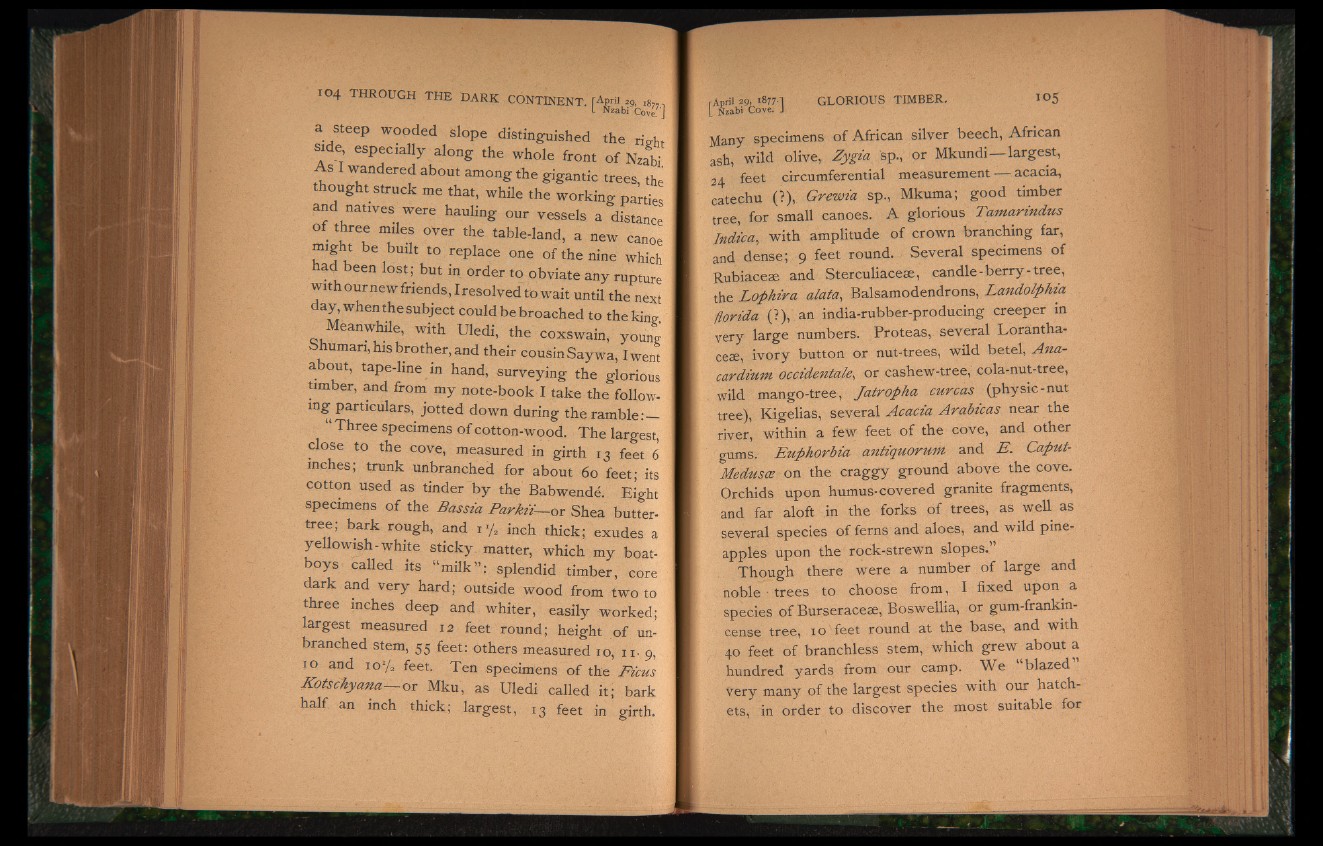
a steep wooded slope distinguished the right
side especially along the whole front of Nzab; I
As I wandered about among the gigantic trees, the
thought struck me that, while the working partiel
and natives were hauling our vessels a distance
of three miles over the table-land, a new canoe
might be built to replace one of the nine which
had been lost; but in order to obviate any rupture
with our new friends, I resolved to wait until the next
day, whenthesubject could be broached to the king
Meanwhile, with Uledi, the coxswain, young
Shuman, his brother, and their cousinSaywa, I went
about, tape-line in hand, surveying the glorious
timber, and from my note-book I take the follow-
mg particulars, jotted down during the ramble:—
“ Three specimens of cotton-wood. The largest,
close to the cove, measured in girth 13 feet 6
inches; trunk unbranched for about 60 feet; its
cotton used as tinder by the Babwende. Eight
specimens of the Bassia Parkn~ox Shea butter-
tree; bark rough, and 1% inch thick; exudes a
yellowish-white sticky, matter, which my boat-
boys called its “milk” : splendid timber, core
dark and very hard; outside wood from two to
three inches deep and whiter, easily worked;
largest measured 12 feet round; height of unbranched
stem, 55 feet: others measured 10, u - 9,
10 and 10% feet. Ten specimens of the Ficus
Kotsckyana— or Mku, as Uledi called it; bark
half an inch thick; largest, 13 feet in girth.
rApril 29, 1877.1 GLORIOUS TIMBER.
[ Nzabi C o v e . J
Many specimens of African silver beech, African
ash, wild olive, Zygia sp., or Mkundi— largest,
24 feet circumferential measurement — acacia,
catechu (?),. Grewia sp., Mkuma; good timber
tree, for small canoes. A glorious Tamarindus
Indica, with amplitude of crown branching far,
and dense; 9 feet round. Several specimens of
Rubiacese and Sterculiaceae, candle-berry-tree,
the Lophira alata, Balsamodendrons, Landolphia
florida (?), an india-rubber-producing creeper in
very large numbers. Proteas,, several Lorantha-
ceae, ivory button or nut-trees, wild betel, Ana-
cardium occidental or cashew-tree, cola-nut-tree,
wild mango-tree, Jatropha curcas (physic-nut
tree), Kigelias, several Acacia Arabicas near the
river, within a few feet of the cove, and other
gums. Euphorbia antiquorum and E . Caput-
Medusce on the craggy ground above the cove.
Orchids upon humus-covered granite fragments,
and far aloft in the forks of trees, as well as
several species of ferns and aloes, and wild pineapples
upon the rock-strewn slopes.”
Though there were a number of large and
noble trees to choose from, I fixed upon a
species of Burseraceae, Boswellia, or gum-frankin-
cense tree, 10 feet round at the base, and with
40 feet of branchless stem, which grew about a
hundred yards from our camp. We “ blazed”
very many of the largest species with our hatchets,
in order to discover the most suitable for